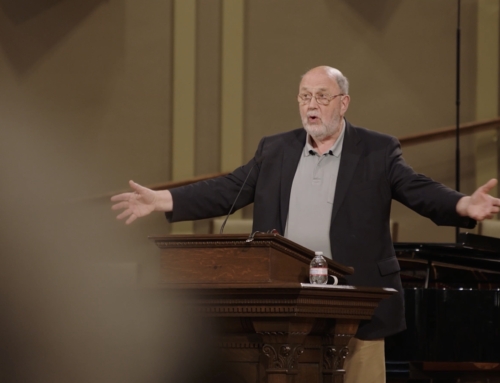We are happy to announce that our next course, ‘Themes in the Gospel of John’, will be available in a few weeks. The best way to prepare is to enroll in N.T. Wright Online’s ‘Worldviews, the Bible, and the Believer’, on sale now for only $49.99 (64% off!)
One of the beautiful things about the story of Jesus given to us in the New Testament is that we have received not one biography of Jesus but four! This uncommon aspect of the Christian faith underscores God’s desire to work with humanity in God’s work of redeeming the world. These four biographies together present the life of Jesus to us. Each one bears the fingerprints of the gospel writers who penned their biographies under the inspiration of the Holy Spirit.
Even a casual reader can pick up on the similarities of the Matthew, Mark, and Luke and the stunning uniqueness of John’s account of Jesus’s life, ministry, death, and ultimate resurrection. Our goal is not so much to try to harmonize these four tellings of the life of Jesus; rather, we should allow each gospel writer to tell their story and as we listen we should imagine the Jesus they are each proclaiming.
John’s Jesus shines like a bright light in a deep, dark forest illuminating the pathway out for lost and lonely travelers. John opens his gospel with ‘In the beginning…’a clear reference to the creation account in Genesis, and then John moves quickly to describe the life in Jesus as “the light of men” (John 1:4). This light shines in the darkness and does not succumb to the dark but overcomes it.
John continues to weave this metaphor of light throughout his gospel. Jesus in John’s gospel is the essence of enlightenment itself revealing truth that had once been hidden under a veil of darkness. Twice John records Jesus calling himself the light of the world, including John 8:12, “I am the light of the world. Whoever follows me will not walk in darkness, but will have the light of life.” John’s Jesus is the light who “enlightens everyone” (John 1:9). In the dark we grope and grasp to understand, but in the light we see as things are revealed to us. Here are five things John’s Jesus reveals to us.
#1 Jesus reveals God’s heart
The overwhelming emphasis in John’s gospel is Jesus reveals to the world who God is and what God is like. John goes so far as to say in his opening that no one has in fact seen God. Not Abraham, not Moses, not David, not the prophets, no one has seen the God of Israel, but “the only God who is at the Father’s side, he has made him known” (John 1:18). John’s Jesus goes on to repeat this theme by saying:
- I do whatever the Father does (John 5:19)
- My teaching is not mine but God’s (John 7:16)
- If you knew me, you would know my Father (John 8:19)
- I do the things that are pleasing to God (John 8:29)
- I and the Father are one (John 10:30; 17:21)
- Whoever sees me, sees God (John 12:45)
Jesus isn’t merely an enlightened man who has seen things others have not seen. Jesus is the exact representation of the heart of God, because John’s Jesus is the embodiment of the one true God of creation. This revelation is good news if we believe it. God really is like Jesus.
Jesus is the exact representation of the heart of God, the embodiment of the one true God of creation. This is good news if we believe it. God really is like Jesus. Click To Tweet
#2 Jesus Reveals Himself as Israel’s Messiah
John’s Jesus reveals himself as the very reflection of the heart of God, Light from Light, true God from true God. Jesus also reveals himself as a true human being, the Word became flesh, dwelling among us. As both true God and fully human, Jesus reveals himself early in John’s gospel as Israel’s promised Messiah.
The story of Jesus has universal appeal, but it isn’t given to us as a sterile transcultural story. It is a specific Jewish story. In his conversation with the Samaritan woman at the well, Jesus reveals that true worship is not a matter of geography but spirit. The woman admits she believes the Messiah, Israel’s king, is coming to reveal all things. In a stunning revelation, Jesus admits, “I who speak to you am he” (John 4:26).
As Israel’s Messiah, Jesus is both Israel’s God in bodily form and the the human representative of all Israel. Jesus takes upon his shoulders the mission and vocation of Israel to be the people of God in and for the world. The messianic longing of all of Israel during the time of Jesus was for the return of the kingdom. The people of God were in their ancestral homeland, but when would God return? They were in the land of Abraham, but when would the God of Abraham come and restore the kingdom and redeem the world? Jesus reveals to the woman at the well that he was the Messiah bringing the kingdom of God. Pilate makes it clear by affixing a sign to the cross of Jesus that read “Jesus of Nazareth, the King of the Jews” (John 19:19). Israel’s long-awaited Messiah had come.
#3 Jesus Reveals a New Hermeneutic
Throughout the gospels Jesus finds himself being tested and questioned by various groups. The usual offenders were the teachers of the law and the Pharisees who commonly challenged each other with their understanding of the law of Moses. In the opening of his gospel, John says the law was given to Moses, and that is good, but “grace and truth came through Jesus Christ” (John 1:17). John’s Jesus is both the conduit of truth and the sum total of truth itself. In keeping with this truth Jesus offers a new hermeneutic, a new way to interpret both the law of Moses and the prophets of the Old Testament.
In discussing the nature of the sabbath with a group of Judeans, Jesus said, “You search the Scriptures because you think that in them you have eternal life; and it is they that bear witness about me” (John 5:39). In this statement, Jesus offers a surprising new way to interpret, what was for them, the Bible. The Scriptures that these Judeans cited concerning sabbath laws were ultimately leading somewhere beyond themselves. They were leading to Jesus. He was the grand subject of all Scripture and so he becomes the way to interpret what the Scriptures mean for both the original listeners and us today.
John’s Jesus is the conduit of truth & sum total of truth. Jesus offers a new hermeneutic, a new way to interpret both the law of Moses and the prophets of the Old Testament. Click To Tweet#4 Jesus reveals a new ethic
When Jesus was gathered with his disciples for a final meal with them before his arrest, he said, “A new commandment I give to you, that you love one another: just as I have loved you, you also are to love one another. By this all people will know that you are my disciples, if you have love for one another” (John 13:34-35). This was a new commandment, a new ethic, rooted in the law of Moses which instructed God’s people to live together in love without hate, bitterness, or vengeance. It was new in that it would dominate and define how the followers of Jesus would answer every moral dilemma. The overarching question would now be, “What is the loving thing to do?”
This love ethic would be defined by Jesus’ very death on the cross. Jesus said, “Greater love has no one than this, that someone lay down his life for his friends” (John 15:13). John’s Jesus calls his followers to a kind of love that is co-suffering and self-giving. A cross-shaped love drives a stake directly in the heart of modern understandings of love as sentimentality. Love for Jesus looks more like faithfulness and suffering than chocolates and flowers. Love for God and love for neighbor, including the love of enemies, would be the defining marker of the people of God under the rule of King Jesus.
#5 Jesus reveals judgment
The light Jesus brings to be the life of men reveals things as they are, including evil and wickedness that is bent upon destroying God’s good world. Judgment was an inescapable part of Jesus’ mission. He said, “For judgment I came into this world, that those who do not see may see, and those who see may become blind” (John 9:39). Jesus clearly admitted that he was sent by the Father not to condemn the world, but to save the world (John 3:17). The judgment Jesus came to bring was not the judgment of hellfire, but a judgment of light.
Jesus described judgment with these words, “And this is the judgment: the light has come into the world, and people loved the darkness rather than the light because their works were evil. For everyone who does wicked things hates the light and does not come to the light, lest his works should be exposed” (John 3:19-21). In one sense “wrath” is what evil looks like when it is exposed by the light of God’s love. God wants to save the world, which means God will deal with, and ultimately dismantle, the presence of evil in God’s world.
God wants to save the world, which means God will deal with, and ultimately dismantle, the presence of evil in God’s world. Click To Tweet
Not only does judgment mean a final removal of evil, but it also includes the demise of death itself. Jesus tells Martha of Bethany “I am the resurrection and the life. Whoever believes in me, though he die, yet shall he live” (John 11:25). Jesus would soon trample down death by his own death and the triumph of death in his resurrection, condemning death once and for all, so we can live as the people of life, living in the light of his love.
Latest posts by Derek Vreeland (see all)
- Reigning from Golgotha’s Hill: 5 Insights from The Day the Revolution Began - April 8, 2022
- A Bright Shining Light: Five Things Revealed to Us by John’s Jesus - August 24, 2018
- Tracing Atonement Through the Story of Scripture - May 21, 2018







